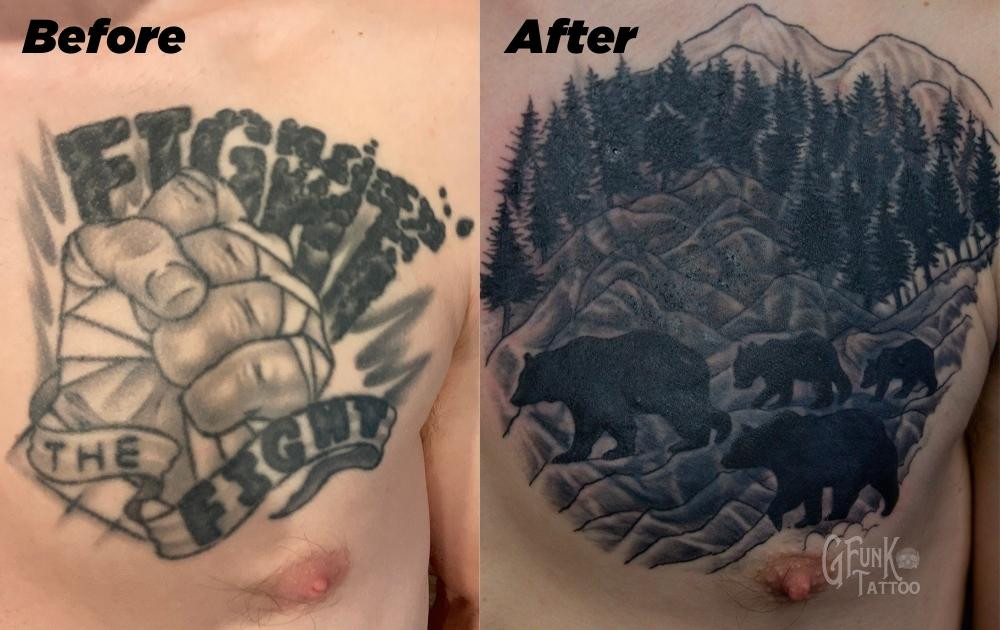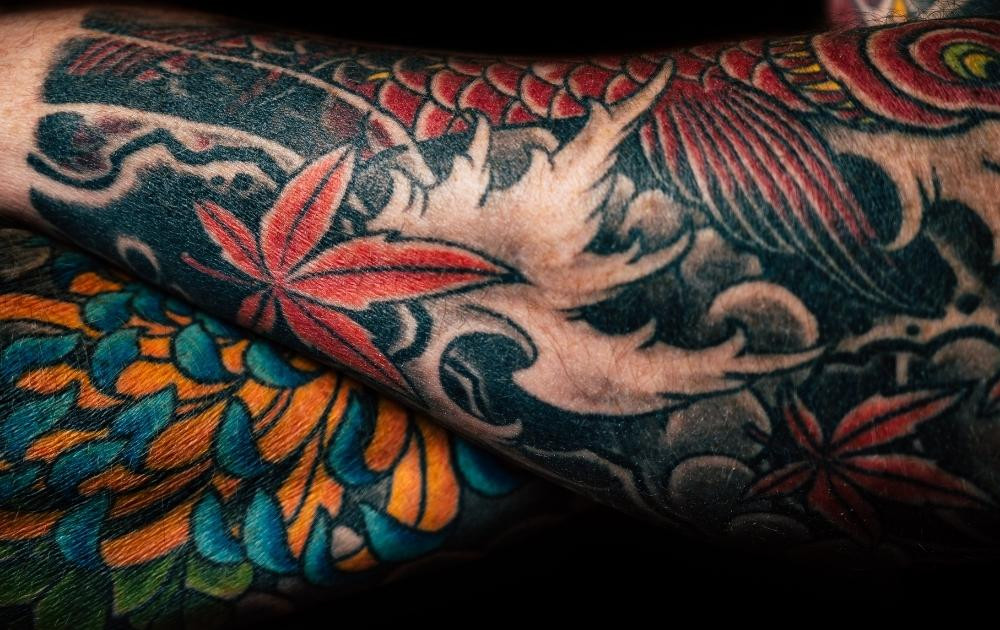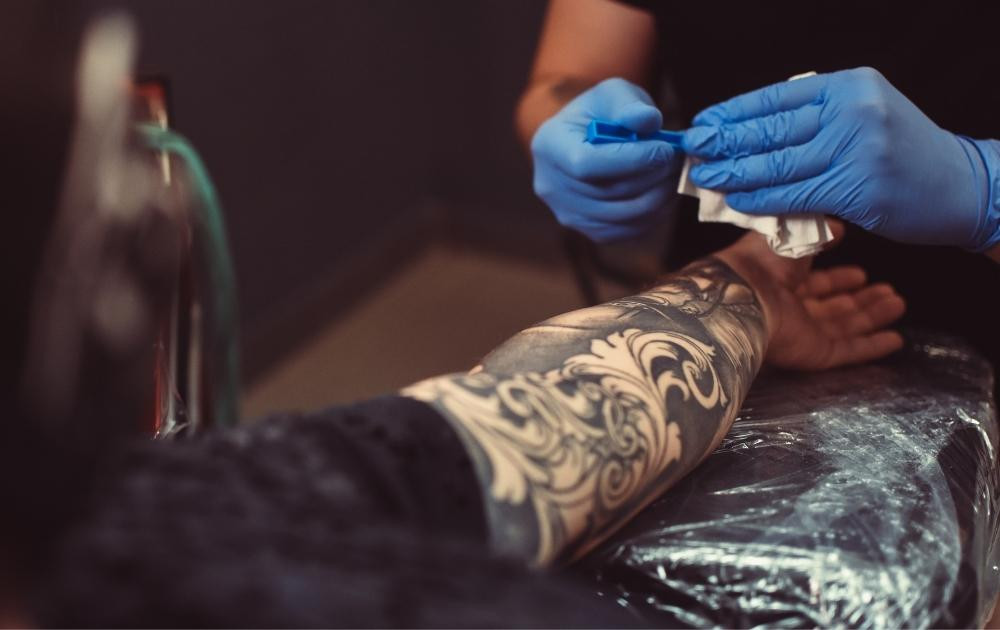Cover up tattoos, an art form designed to conceal existing ink, are a popular solution for those seeking to refresh or transform their body art; here at tattooat.com, we understand the nuances of this process and will explore whether the healing journey of a cover up tattoo differs from that of a fresh piece, providing you with the insights needed for a successful and vibrant transformation. Understanding these differences is crucial for proper aftercare and ensuring the longevity of your tattoo, making informed decisions about tattoo modifications, exploring tattoo modification aftercare tips, and gaining insights into the tattoo transformation process.
1. Do Cover Up Tattoos Heal Differently Compared to New Tattoos?
Yes, cover up tattoos generally heal differently than new tattoos due to several factors; the primary reason is that the skin has already been traumatized by the original tattoo. The skin needs to recover from a double layer of ink, which can extend the healing time and require more diligent aftercare.
1.1. Understanding the Healing Process of a Standard Tattoo
The standard tattoo healing process typically involves several stages:
- Week 1: The tattoo will appear red, swollen, and tender. It’s crucial to keep the area clean and moisturized.
- Week 2: The tattoo starts to scab over. Avoid picking at the scabs to prevent ink loss and scarring.
- Weeks 3-4: The scabs begin to fall off, and the tattoo may look shiny or milky. The skin is still healing beneath the surface.
- Months 2-6: The tattoo is fully healed, and the colors settle into their final appearance.
1.2. Why Cover Up Tattoos Pose Unique Healing Challenges
Cover up tattoos present unique challenges because the artist is working over skin that already contains ink. This means:
- Increased Trauma: The skin undergoes additional trauma from the new tattooing process, which can lead to more inflammation and a longer healing period.
- Ink Saturation: Multiple layers of ink can make the area more susceptible to infection and may affect how the skin absorbs and retains the new ink.
- Design Complexity: Cover ups often require more intricate designs and heavier shading to effectively conceal the old tattoo, further stressing the skin.
2. What Factors Influence the Healing of Cover Up Tattoos?
Several factors can influence how a cover up tattoo heals, including the size, location, and complexity of the design, as well as individual skin characteristics and aftercare practices.
2.1. Tattoo Size and Location
- Size: Larger cover ups naturally require more extensive work, leading to a longer healing time.
- Location: Areas with more friction, such as joints or places where clothing rubs, may take longer to heal. According to research from Portland State University’s Art Department, in July 2025, tattoo placement significantly impacts healing duration.
2.2. Design Complexity and Ink Density
- Complexity: Intricate designs with fine lines and detailed shading can cause more trauma to the skin.
- Ink Density: Cover ups typically require more ink to effectively conceal the original tattoo, potentially prolonging the healing process.
2.3. Skin Type and Individual Healing Ability
- Skin Type: Different skin types react differently to tattooing. For example, sensitive skin may experience more inflammation and require extra care.
- Individual Healing Ability: Some people naturally heal faster than others due to factors like genetics, age, and overall health.
2.4. Aftercare Practices
- Cleaning: Proper cleaning with mild, fragrance free soap is essential to prevent infection.
- Moisturizing: Regular moisturizing helps keep the skin hydrated and promotes healing.
- Sun Protection: Protecting the tattoo from sun exposure prevents fading and damage.
3. What Are the Key Differences in Healing Between Cover Up and Regular Tattoos?
The key differences in healing between cover up and regular tattoos lie in the duration, intensity, and potential complications during the healing process.
3.1. Duration of Healing
- Cover Up Tattoos: Typically take longer to heal, often extending the initial healing phase by one to two weeks.
- Regular Tattoos: Generally heal within the standard four to six week timeframe.
3.2. Intensity of Initial Symptoms
- Cover Up Tattoos: May exhibit more pronounced redness, swelling, and tenderness in the first week.
- Regular Tattoos: Symptoms are usually milder and subside more quickly.
3.3. Potential Complications
- Cover Up Tattoos: Increased risk of infection due to the skin undergoing more trauma. Also, there’s a heightened chance of ink rejection or uneven healing.
- Regular Tattoos: Lower risk of complications if proper aftercare is followed.
4. What Aftercare Steps Should I Take to Ensure Proper Healing of My Cover Up Tattoo?
Proper aftercare is crucial for the successful healing of a cover up tattoo. Here’s a detailed guide to ensure the best results:
4.1. Immediate Aftercare (First Few Days)
- Keep it Clean: Gently wash the tattoo with mild, fragrance free soap and lukewarm water two to three times a day.
- Pat Dry: Use a clean paper towel to pat the area dry, avoiding any rubbing.
- Apply Ointment: Apply a thin layer of a recommended tattoo aftercare ointment. Many artists recommend Aquaphor or similar products.
4.2. Ongoing Care (Weeks 1-4)
- Moisturize Regularly: Apply a fragrance free lotion several times a day to keep the skin hydrated.
- Avoid Sun Exposure: Keep the tattoo covered and out of direct sunlight to prevent fading.
- Stay Hydrated: Drinking plenty of water helps keep your skin healthy and promotes healing.
4.3. Precautions to Take
- Avoid Soaking: Do not soak the tattoo in water (baths, swimming) for at least two weeks.
- Don’t Pick: Resist the urge to pick at scabs, as this can lead to scarring and ink loss.
- Wear Loose Clothing: Avoid tight clothing that can rub against the tattoo.
5. What Are Signs of Improper Healing in a Cover Up Tattoo?
Recognizing signs of improper healing is essential for addressing potential issues promptly and ensuring the tattoo heals correctly.
5.1. Common Signs of Infection
- Excessive Redness or Swelling: Redness and swelling that worsen over time.
- Pus or Drainage: Any discharge from the tattoo area.
- Fever or Chills: Systemic symptoms indicating a possible infection.
- Increased Pain: Pain that intensifies rather than diminishes.
5.2. Indications of Ink Rejection
- Bumpy Skin: Small bumps or raised areas around the tattoo.
- Fading Ink: Noticeable loss of ink in certain areas.
- Itchiness: Persistent and intense itching that doesn’t subside with moisturizing.
5.3. When to Seek Professional Medical Advice
If you experience any of these signs, it’s crucial to seek medical advice from a healthcare professional or a tattoo artist experienced in recognizing and treating complications. Early intervention can prevent more severe issues and ensure the tattoo heals properly.
6. What Are Some Common Complications Associated with Cover Up Tattoo Healing?
Several complications can arise during the healing of a cover up tattoo, primarily due to the increased trauma and ink saturation in the skin.
6.1. Infection
- Causes: Bacteria entering the skin through broken or compromised barriers.
- Prevention: Maintaining strict hygiene, using antibacterial soaps, and avoiding unsanitized environments.
6.2. Allergic Reactions
- Causes: Sensitivity to the tattoo ink or aftercare products.
- Prevention: Patch testing new inks or products and opting for hypoallergenic options.
6.3. Scarring
- Causes: Excessive trauma to the skin, picking at scabs, or individual skin predisposition.
- Prevention: Following proper aftercare, avoiding irritation, and consulting with the tattoo artist about techniques to minimize scarring.
6.4. Ink Fading or Migration
- Causes: Poor ink quality, improper application, or sun exposure.
- Prevention: Choosing a reputable artist, protecting the tattoo from the sun, and using high quality inks.
7. Can Laser Tattoo Removal Improve the Healing Process for a Future Cover Up?
Yes, laser tattoo removal can significantly improve the healing process for a future cover up by lightening the existing tattoo and reducing the amount of new ink needed.
7.1. How Laser Removal Works
Laser tattoo removal breaks down the ink particles in the skin, allowing the body to absorb and eliminate them. Multiple sessions are usually required for significant lightening.
7.2. Benefits of Lightening Before a Cover Up
- Less Trauma to the Skin: Reduces the amount of new ink needed, minimizing trauma and potential complications.
- Wider Design Options: Allows for more design flexibility as the artist doesn’t need to completely conceal a dark tattoo.
- Improved Healing: Lighter ink density promotes faster and more even healing.
7.3. Considerations for Laser Removal
- Cost: Laser removal can be expensive and requires multiple sessions.
- Time: The process can take several months to years, depending on the tattoo’s size, color, and ink density.
- Skin Sensitivity: Laser treatment can cause temporary skin sensitivity and requires proper aftercare.
8. Are There Specific Inks or Techniques That Promote Better Healing for Cover Up Tattoos?
Yes, certain inks and techniques can promote better healing for cover up tattoos, focusing on reducing trauma and ensuring optimal ink retention.
8.1. Ink Considerations
- High Quality Inks: Using reputable brands with high pigment concentration ensures better coverage and longevity.
- Hypoallergenic Inks: Reducing the risk of allergic reactions and promoting smoother healing.
- Organic Inks: Considered safer due to fewer harmful chemicals.
8.2. Tattooing Techniques
- Light Shading: Using lighter shading techniques minimizes skin trauma and promotes even healing.
- Strategic Layering: Applying ink in strategic layers to avoid oversaturation.
- Needle Choice: Selecting appropriate needle groupings and sizes to reduce skin damage.
8.3. Alternative Techniques
- Micro Needling: Enhancing ink absorption and collagen production for better skin health.
- Dry Tattooing: Reducing bleeding and promoting faster healing by minimizing moisture.
9. How Does Diet and Lifestyle Affect Cover Up Tattoo Healing?
Diet and lifestyle play a crucial role in the healing process of a cover up tattoo by supporting overall skin health and immune function.
9.1. Nutritional Considerations
- Protein: Essential for skin repair and collagen production.
- Vitamins: Vitamins A, C, and E promote skin health and reduce inflammation.
- Minerals: Zinc and iron support immune function and wound healing.
- Hydration: Drinking plenty of water keeps the skin hydrated and aids in nutrient transport.
9.2. Lifestyle Choices
- Avoid Smoking: Smoking impairs blood flow and delays healing.
- Limit Alcohol: Alcohol can thin the blood and increase inflammation.
- Get Enough Sleep: Adequate rest supports immune function and skin regeneration.
- Manage Stress: High stress levels can compromise the immune system and slow healing.
10. What Are the Best Tattoo Styles for Cover Up Tattoos That Heal Well?
Certain tattoo styles are better suited for cover ups and tend to heal more effectively due to their design characteristics and ink application techniques.
10.1. Styles That Work Best
- Blackwork: Bold, solid black designs effectively cover old tattoos and heal well due to the simplicity and ink density.
- Traditional: Classic designs with thick lines and strong colors provide excellent coverage and durability.
- Neo Traditional: Similar to traditional but with more detail and color variations, offering both coverage and artistic expression.
- Abstract: Abstract designs can creatively camouflage old tattoos by using shapes, patterns, and colors to distract from the original ink.
10.2. Styles to Approach with Caution
- Watercolor: Light and airy, watercolor tattoos may not provide enough coverage for darker tattoos.
- Fine Line: Intricate fine line designs may require multiple passes, increasing skin trauma and potentially affecting healing.
- Minimalist: Simple designs may not be sufficient to cover the old tattoo effectively.
11. Frequently Asked Questions (FAQs) About Cover Up Tattoo Healing
11.1. How long does a cover up tattoo take to heal completely?
A cover up tattoo typically takes 4-8 weeks to heal completely, but it can vary based on individual factors such as skin type, tattoo size, and aftercare practices.
11.2. Can I use numbing cream during the cover up process?
Yes, numbing cream can be used, but it’s essential to consult with your tattoo artist first; some creams may affect the skin’s texture and ink absorption.
11.3. Is it normal for a cover up tattoo to itch more than a regular tattoo?
Yes, it’s common for cover up tattoos to itch more due to the additional trauma and ink in the skin.
11.4. What should I do if my cover up tattoo is oozing?
Gently clean the area with mild soap and water, pat dry, and apply a thin layer of aftercare ointment; if the oozing persists or is accompanied by other signs of infection, seek medical advice.
11.5. Can I exercise after getting a cover up tattoo?
Avoid strenuous activities for the first few days to prevent excessive sweating and friction; when you resume exercising, wear loose clothing and keep the area clean.
11.6. How often should I moisturize my cover up tattoo?
Moisturize the tattoo several times a day to keep the skin hydrated, especially after washing.
11.7. Can I get a cover up tattoo if I have sensitive skin?
Yes, but it’s essential to choose hypoallergenic inks and follow a gentle aftercare routine to minimize irritation.
11.8. What are the best aftercare products for cover up tattoos?
Look for fragrance free, hypoallergenic lotions and ointments specifically designed for tattoo aftercare, such as Aquaphor, and Tattoo Goo.
11.9. How can I prevent my cover up tattoo from fading?
Protect the tattoo from sun exposure by wearing sunscreen or covering it with clothing; also, stay hydrated and maintain a healthy lifestyle.
11.10. Is it possible to cover up a dark tattoo with a lighter color?
It’s challenging, but possible with the right artist and design; laser tattoo removal may be necessary to lighten the old tattoo before applying the cover up.
In conclusion, while cover up tattoos may present unique healing challenges compared to regular tattoos, understanding these differences and following proper aftercare practices can lead to a successful and vibrant transformation; remember, tattooat.com is here to guide you through every step of your tattoo journey. Ready to explore stunning tattoo designs, find talented artists, and learn more about tattoo aftercare? Visit tattooat.com today and start your transformation! Contact us at Address: 1825 SW Broadway, Portland, OR 97201, United States or Phone: +1 (503) 725-3000. Website: tattooat.com.
 A cover-up tattoo done by The Fall from a fist to a forest
A cover-up tattoo done by The Fall from a fist to a forest
 A cover-up tattoo on someones forearm.
A cover-up tattoo on someones forearm.
 An artist busy covering up a tattoo.
An artist busy covering up a tattoo.